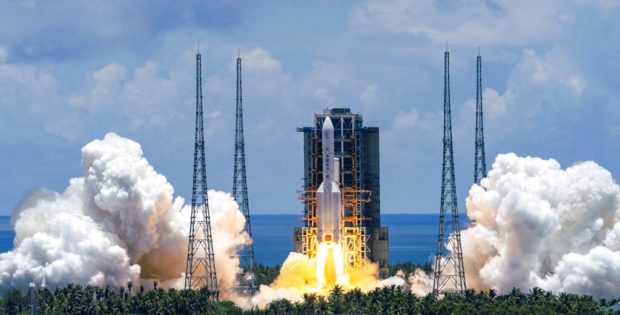
[ad_1]

FILE – In this July 23, 2020, file photo released by China’s Xinhua News Agency, a Long March-5 rocket carrying the Tianwen-1 Mars probe lifts off from the Wenchang Space Launch Center in southern China’s Hainan Province. China’s Mars probe Tianwen-1, which blasted into space in July, is now more than 15 million kilometers (9 million miles) from Earth en route to the red planet, the National Space Administration said Saturday, Sept. 12, 2020. (Cai Yang/Xinhua via AP)
BEIJING— China’s Mars probe Tianwen-1, which blasted into space in July, is now more than 15 million kilometers (9 million miles) from Earth en route to the red planet, the National Space Administration said Saturday.
The administration said that Tianwen-1 was in stable condition, having completed its first mid-course orbital correction early last month. It will be about 195 million kilometers (118 million miles) from Earth when it arrives at Mars around February, having traveled 470 million kilometers (292 million miles) in all to get there.
The administration, however, has yet to release information about a mysterious reusable experimental spacecraft that returned to Earth a week ago after a two-day flight.
The spacecraft consists of an orbiter, a lander and a rover, and marks China’s most ambitious Mars mission yet as it seeks to join the United States in successfully landing a spacecraft on the planet. It was blasted into space aboard a Long March-5 on July 23 during a month when the United Arab Emirates and the U.S. also took advantage of a shortened distance between the planets to launch similar missions.
China said the reusable spacecraft returned to its designated landing site last Sunday, calling the flight a breakthrough that will eventually provide convenient round-trip transport to space at a low cost. No other details on the mission or the configuration of the spacecraft have been released.
That is also seen as an attempt to put China on the leading edge of space flight. The U.S. has for years been operating the secretive X-37B space plane that remains in orbit for months.
China’s military-backed space program has developed rapidly since it became just the third country after Russia and the U.S. to put a man in space in 2003. Last year, China’s Chang’e-4 became the first spacecraft from any country to land on the far side of the moon.
The program has also suffered the occasional setback. The northwestern satellite launch center of Jiuquan reported that an optical satellite launched midday Saturday failed to enter its preset orbit after abnormalities were observed during the flight of its carrier rocket.
Read Next
EDITORS’ PICK
MOST READ
Subscribe to INQUIRER PLUS to get access to The Philippine Daily Inquirer & other 70+ titles, share up to 5 gadgets, listen to the news, download as early as 4am & share articles on social media. Call 896 6000.
For feedback, complaints, or inquiries, contact us.
[ad_2]
Source link

